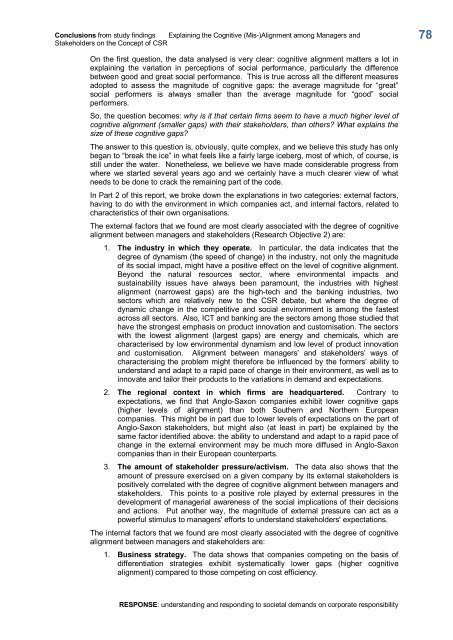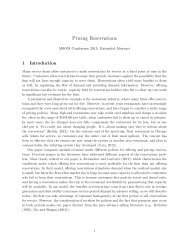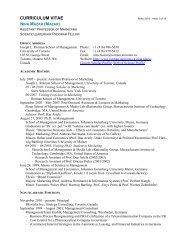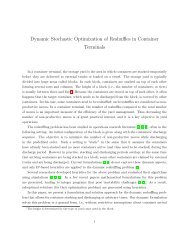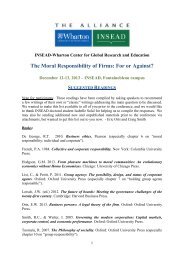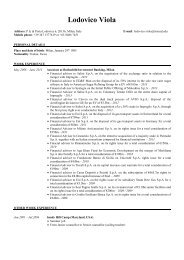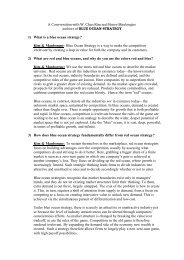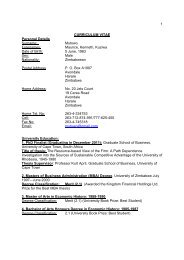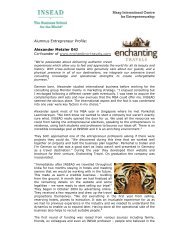RESPONSE - Insead
RESPONSE - Insead
RESPONSE - Insead
You also want an ePaper? Increase the reach of your titles
YUMPU automatically turns print PDFs into web optimized ePapers that Google loves.
Conclusions from study findings Explaining the Cognitive (Mis)Alignment among Managers and<br />
Stakeholders on the Concept of CSR<br />
On the first question, the data analysed is very clear: cognitive alignment matters a lot in<br />
explaining the variation in perceptions of social performance, particularly the difference<br />
between good and great social performance. This is true across all the different measures<br />
adopted to assess the magnitude of cognitive gaps: the average magnitude for “great”<br />
social performers is always smaller than the average magnitude for “good” social<br />
performers.<br />
So, the question becomes: why is it that certain firms seem to have a much higher level of<br />
cognitive alignment (smaller gaps) with their stakeholders, than others? What explains the<br />
size of these cognitive gaps?<br />
The answer to this question is, obviously, quite complex, and we believe this study has only<br />
began to “break the ice” in what feels like a fairly large iceberg, most of which, of course, is<br />
still under the water. Nonetheless, we believe we have made considerable progress from<br />
where we started several years ago and we certainly have a much clearer view of what<br />
needs to be done to crack the remaining part of the code.<br />
In Part 2 of this report, we broke down the explanations in two categories: external factors,<br />
having to do with the environment in which companies act, and internal factors, related to<br />
characteristics of their own organisations.<br />
The external factors that we found are most clearly associated with the degree of cognitive<br />
alignment between managers and stakeholders (Research Objective 2) are:<br />
1. The industry in which they operate. In particular, the data indicates that the<br />
degree of dynamism (the speed of change) in the industry, not only the magnitude<br />
of its social impact, might have a positive effect on the level of cognitive alignment.<br />
Beyond the natural resources sector, where environmental impacts and<br />
sustainability issues have always been paramount, the industries with highest<br />
alignment (narrowest gaps) are the hightech and the banking industries, two<br />
sectors which are relatively new to the CSR debate, but where the degree of<br />
dynamic change in the competitive and social environment is among the fastest<br />
across all sectors. Also, ICT and banking are the sectors among those studied that<br />
have the strongest emphasis on product innovation and customisation. The sectors<br />
with the lowest alignment (largest gaps) are energy and chemicals, which are<br />
characterised by low environmental dynamism and low level of product innovation<br />
and customisation. Alignment between managers’ and stakeholders’ ways of<br />
characterising the problem might therefore be influenced by the formers’ ability to<br />
understand and adapt to a rapid pace of change in their environment, as well as to<br />
innovate and tailor their products to the variations in demand and expectations.<br />
2. The regional context in which firms are headquartered. Contrary to<br />
expectations, we find that AngloSaxon companies exhibit lower cognitive gaps<br />
(higher levels of alignment) than both Southern and Northern European<br />
companies. This might be in part due to lower levels of expectations on the part of<br />
AngloSaxon stakeholders, but might also (at least in part) be explained by the<br />
same factor identified above: the ability to understand and adapt to a rapid pace of<br />
change in the external environment may be much more diffused in AngloSaxon<br />
companies than in their European counterparts.<br />
3. The amount of stakeholder pressure/activism. The data also shows that the<br />
amount of pressure exercised on a given company by its external stakeholders is<br />
positively correlated with the degree of cognitive alignment between managers and<br />
stakeholders. This points to a positive role played by external pressures in the<br />
development of managerial awareness of the social implications of their decisions<br />
and actions. Put another way, the magnitude of external pressure can act as a<br />
powerful stimulus to managers' efforts to understand stakeholders' expectations.<br />
The internal factors that we found are most clearly associated with the degree of cognitive<br />
alignment between managers and stakeholders are:<br />
1. Business strategy. The data shows that companies competing on the basis of<br />
differentiation strategies exhibit systematically lower gaps (higher cognitive<br />
alignment) compared to those competing on cost efficiency.<br />
<strong>RESPONSE</strong>: understanding and responding to societal demands on corporate responsibility<br />
78


